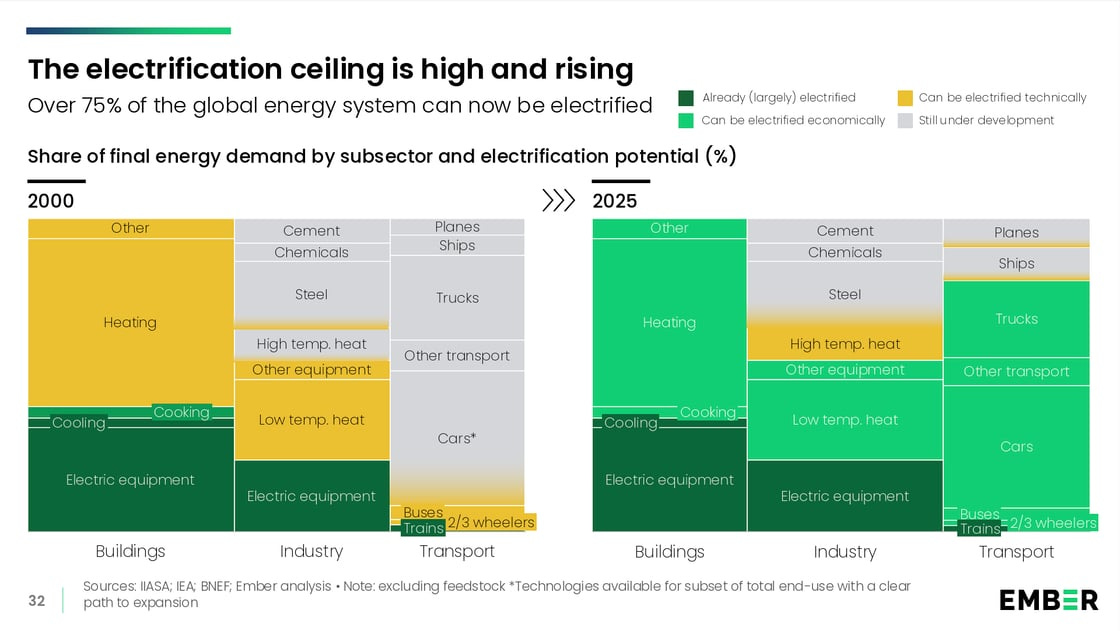How the “Electrotech Revolution” reframes the energy debate (and why we’re here for it)

Our friends at Ember, a global energy think tank that also advises us at Carbon Equity, just released their latest annual presentation titled “The Electrotech Revolution.” Ember has been tracking a whole range of metrics on how the energy transition is going, and I would certainly recommend exploring more of their research. They also do a great job at forming a new way of understanding the energy transition. One that we certainly get excited about at Carbon Equity, and I am eager to share with you.
📹 P.S: Daan Walter, one of the report’s authors, is joining us for a webinar on October 14th, 5 pm to break it all down. He will be accompanied by expert investors Hein Ploegmakers from Gilde Climate and Helmer Schukken from Rubio Impact Ventures to discuss investment perspectives on the energy transition.
“The Electrotech Revolution” deck has over 100 slides laying out this perspective and bringing a massive amount of data and insights, which I highly encourage you to dig into.
This newsletter breaks down some of my favourite slides (needless to say, we had to make hard choices 😉)
👀 A shift in perspective
Today’s energy debate can sometimes feel stale, stuck between “fossil gradualists,” who insist oil, gas, and coal remain essential and downplay clean energy progress, and “net-zero puritans,” who see the system purely as a carbon problem demanding strict government action. But neither perspective can truly account for the scale or speed of the energy transition that is happening.

Ember’s analysis proposes a third way, one that frames the transition as simply building a fundamentally better and more efficient energy system, organized around electricity. It shifts away from an exclusively climate-focused narrative toward a more practical framework based on system efficiency, economics, and geopolitics.
Of course, tackling climate change remains the key motivation for me and the Carbon Equity team, but this perspective rewires the conversation entirely. We’re moving from thinking about decarbonization as a political choice with limited upside, to positioning solving climate change as a “byproduct” of an energy transition that is driven by economic and geopolitical forces, is already happening at speed, and where dragging our feet on these technologies will harm our future prosperity.
🔋 What is electrotech?
Before we dive in, let’s clarify what we mean by “electrotech.” Ember defines it as the convergence of 3 electricity-centric technology clusters reshaping how we produce, transport and store, and use electrons: it covers a wide range of technologies including solar and wind power; intelligent connectivity through battery storage and digital systems; and electrified consumption via electric vehicles and heat pumps.
It’s this convergence of our ability to effectively produce, use, and transport sustainable electricity that has flipped the script in terms of which energy system is the cheapest and most efficient, and hence which one is winning. Indeed, Electrotech costs have been falling for decades: solar, wind, and batteries have gotten ~20% cheaper every time global capacity doubled. After decades on this curve, they’re now so cheap that they beat fossil fuels on price in most parts of the world.

🚀 The fundamentals driving change
Behind all these curves, Ember names three fundamental forces at work: physics, economics, and geopolitics. At risk of pointing out the obvious: none of these are about moral imperatives or policy mandates; they’re hard realities that make electrotech the obvious choice. You don’t need to care about polar bears or feel guilty about your carbon footprint to see why Electrotech wins. The physics of efficiency, the economics of falling costs, and the geopolitics of energy independence all create their own compelling logic.
🔬 The physics: efficiency that changes everything
The electrotech perspective highlights the absurdity of combustion-based energy systems, which waste two-thirds of their input energy - worth $4.6 trillion. Every year. Fossil fuels are excellent at one thing: producing heat. But converting heat to electricity or movement is where we waste enormous amounts of energy.
Electrotech bypasses these thermal conversion losses and delivers huge efficiency gains: wind & solar are 2-3x as efficient as gas power plants, EVs are 2-4x more efficient than internal combustion engines, and a heat pump is 3-4x more efficient than a gas boiler. In short, renewables and electrification unlock a big leap in energy efficiency across the whole economy.

💰 The economics: scale vs. scarcity
The financial mathematics are equally striking, following a clear pattern: manufactured technologies become more affordable through learning curves as we perfect designs and production with each unit made. We’ve optimized fossil fuel extraction for 200+ years. But now the costs stay high because we’re fighting geology not manufacturing inefficiency. We’ve only gotten serious about renewable manufacturing in the past 20 years, meaning there’s enormous cost reduction potential still untapped.

The cost structures are also fundamentally different: renewables are a CAPEX game (pay upfront for the panel/turbine) while fossil fuels are an OPEX game (buy fuel every day, forever). Manufacturing costs fall predictably with scale, but extraction costs rise as easy deposits run out and we’re forced to drill deeper in harsher conditions. This creates cost trajectory divergence. The intersection point isn’t theoretical anymore. It’s the current reality across multiple markets. Fossil fuel prices are volatile, but there is no learning curve that creates a sustained fall in cost - only the relentless march toward scarcity.
🌍 The geopolitics: the race to independence
Energy independence has become a national security priority for many countries in 2025. Relying on expensive imported fossil fuels makes countries vulnerable to global price swings. This is more than a short-term problem. It puts jobs, industry and long-term competitiveness at risk.
In today’s system, fossil fuel import dependency is widespread and expensive: 75% of the world population is a net importer of fossil fuels, and over a quarter of the world spends over 5% of its GDP on annual fossil fuel imports.

The good news is: with just a few electrotech technologies (like wind and solar, EVs, and heat pumps), we could already reduce the global net spending on imports by 70%, saving importers $1.3 trillion globally each year.

Electrotech offers a two-pronged security strategy. First, because virtually every nation could achieve energy self-sufficiency through local renewable resources. Second, by electrifying end-use sectors like transport and heating to use domestic electricity instead of fossil fuels. While electrotech doesn’t lead to full independence if a country is still importing the technologies, Electrotech infrastructure, once installed, operates independently for decades without exposure to international price volatility. This transition also further shifts power from resource-rich nations to technology leaders and manufacturing hubs.
🔮 Looking ahead
The technological progress to date has surpassed what almost any expert predicted, including the rapid price decreases, the explosive growth of renewables, and EVs becoming mainstream. But it’s not just about cost or quality anymore: it’s about how the ceiling of what we thought was possible keeps rising.
25 years ago, we thought renewables might power 25% of the global economy, and just 7 years ago, when I worked at McKinsey, experts didn’t believe we could electrify residential heating or long-haul trucking. Today we can. At equal cost to fossil fuels.

These fundamental drivers (physics, economics, and geopolitics) are already driving 75% of the energy transition. Once again, the question isn’t whether the electrotech revolution will happen - it’s: how quickly will the first 75% of the energy system electrify? And, when will we develop the right technology with which the remaining 25% will follow?
This framework perfectly captures what we’ve been seeing across our investment landscape at Carbon Equity. We’ve been backing managers who understand these fundamental shifts, but no one has spelled it out better than the Ember team, and it crystallizes why this moment feels so compelling. Of course, this transformation won’t be seamless. Entrenched interests will fight to preserve the status quo, and there will be bumps along the way. But the fundamentals don’t lie. We’re not just witnessing the end of one system, but the birth of something fundamentally superior. The fact that this technology happens to be exactly what we need for our climate goals?
That’s just our luck.
🗞️ Carbon Equity Update
🚨 Our Climate Tech Portfolio Fund IV is nearing its first close on September 30, 2025. This means you have 5 days left to reserve your investment with a discount.

Hopefully, the overview of Ember’s report above has convinced you that climate technologies are at the center of an energy revolution. 😉 The Climate Tech Portfolio Fund IV offers exposure to 7–10 top-tier VC and PE funds focused on breakthrough climate technologies. In one single investment, you will be backing 150+ early and growth-stage companies across energy, industry, food, and transport with a target net return of 12-15% IRR.
Log in or create an account to learn more about the investment opportunity 🔗👇
𝘛𝘩𝘪𝘴 𝘪𝘴 𝘢 𝘮𝘢𝘳𝘬𝘦𝘵𝘪𝘯𝘨 𝘤𝘰𝘮𝘮𝘶𝘯𝘪𝘤𝘢𝘵𝘪𝘰𝘯. 𝘊𝘢𝘳𝘣𝘰𝘯 𝘌𝘲𝘶𝘪𝘵𝘺 𝘪𝘴 𝘢 𝘧𝘶𝘯𝘥 𝘮𝘢𝘯𝘢𝘨𝘦𝘳 𝘭𝘪𝘤𝘦𝘯𝘴𝘦𝘥 𝘶𝘯𝘥𝘦𝘳 𝘢𝘳𝘵𝘪𝘤𝘭𝘦 2:65 𝘞𝘧𝘵 𝘢𝘯𝘥 𝘪𝘴 𝘪𝘯𝘤𝘭𝘶𝘥𝘦𝘥 𝘪𝘯 𝘵𝘩𝘦 𝘈𝘍𝘔 𝘳𝘦𝘨𝘪𝘴𝘵𝘦𝘳. 𝘗𝘭𝘦𝘢𝘴𝘦 𝘳𝘦𝘧𝘦𝘳 𝘵𝘰 𝘵𝘩𝘦 𝘧𝘶𝘯𝘥’𝘴 𝘐𝘯𝘧𝘰𝘳𝘮𝘢𝘵𝘪𝘰𝘯 𝘔𝘦𝘮𝘰𝘳𝘢𝘯𝘥𝘶𝘮 𝘢𝘯𝘥 𝘵𝘰 𝘵𝘩𝘦 𝘌𝘐𝘋 𝘣𝘦𝘧𝘰𝘳𝘦 𝘮𝘢𝘬𝘪𝘯𝘨 𝘢𝘯𝘺 𝘧𝘪𝘯𝘢𝘭 𝘪𝘯𝘷𝘦𝘴𝘵𝘮𝘦𝘯𝘵 𝘥𝘦𝘤𝘪𝘴𝘪𝘰𝘯𝘴.
💡 News from within our funds
🔋 Group14 raises $463M in Series D funding
☢️ Equinix orders 20 Kaleidos microreactors from Radiant in latest nuclear deal
🧂 Stellaria delivers 500 MWe via first-of-its-kind molten-salt reactors for Equinix
🏅 Radiant is selected as one of the 11 companies with which the DOE will work to move their technologies towards deployment
♨️ Aira raises €150m to fund heat pump rollout across Europe
⚡️ Electric Hydrogen acquires Ambient Fuels
🌱 Nitricity raises $50M to go global with unique tech transforming almond waste into organic fertilizer
🇳🇱 LeydenJar closes new investment round to launch first 100% silicon anode production facility
Already investing with us? You can now follow the latest news on your personal investments directly on our platform, here.
📚 Interesting reads
Cheap, clean, homegrown energy is a no-brainer (In Dutch)
The case for domestic renewables. This FD piece argues that cheap, clean, homegrown energy should be the obvious choice, both economically and geopolitically. Beyond emissions reductions, it highlights how local wind and solar can reduce dependence on volatile global markets and strengthen national resilience.
Why renewables now need climate insurance
Insuring against the very thing you’re fighting. Bloomberg reports on a new paradox: renewable energy projects designed to combat climate change now increasingly need insurance to cover damages from climate-fueled disasters themselves. Rising premiums and coverage challenges could reshape the risk-return equation for developers and investors alike.
Northern Lights stores CO₂ under the North Sea
A world-first for carbon capture and storage. As part of Norway’s Longship initiative, Northern Lights enables industrial emitters across Europe to ship captured CO2 to a central terminal at Øygarden, where it is piped and stored 2,600 meters beneath the seabed. This is a new milestone for CCS for decarbonizing hard-to-abate sectors.
Wind and solar generate over a third of Brazil’s electricity for the first time
A milestone moment in Latin America’s energy transition. Ember’s analysis shows that Brazil hit a record in August, with wind and solar supplying more than one-third of total electricity generation for the month. A powerful example of how emerging economies are leapfrogging fossil fuel dependence with renewables at scale.



